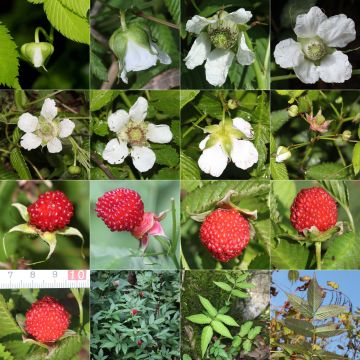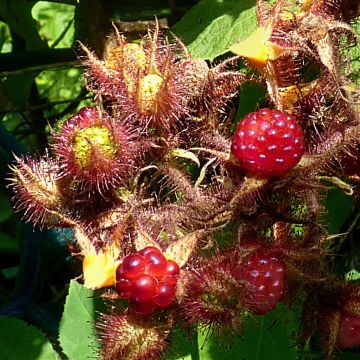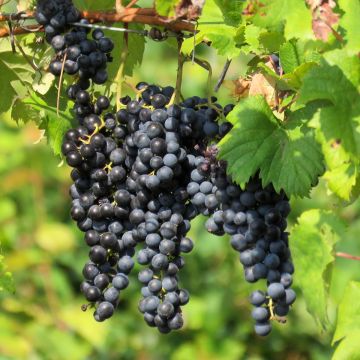

Rubus fruticosus Black Cascade - Blackberry
Rubus fruticosus Black Cascade - Blackberry
Rubus fruticosus Black Cascade®
Blackberry, Bramble
This plant arrived in poor condition with broken branches. It produced only one berry but didn't show great vigor. I'm waiting to see how it recovers after the winter.
Sara, 29/12/2024
This item cannot be shipped to the selected country
Delivery charge from €5.90
More information
Schedule delivery date,
and select date in basket
This plant carries a 6 months recovery warranty
More information
We guarantee the quality of our plants for a full growing cycle, and will replace at our expense any plant that fails to recover under normal climatic and planting conditions.
From €5.90 for pickup delivery and €6.90 for home delivery
Express home delivery from €8.90.

Description
Rubus fruticosus 'Black Cascade' is a robust and hardy plant, both ornamental and fruit-bearing. This dwarf variety, with trailing branches and thornless stems, offers a harvest of black and juicy blackberries weighing up to 1.3kg. Its short and weeping stems are thornless and adorned with white flowers in June-July. Harvest the blackberries from mid-August until October. The fruits are a delight to enjoy fresh or in coulis, jellies, jams, pies, and fruit salads. Well-drained soil rich in humus and nutrients and a sunny to shady location are the optimal conditions for good fruiting. Planting is recommended in autumn or spring for regions with cold or humid winters.
Rubus belongs to the Rosaceae family, and is native to the mountains of the Caucasus in Asia Minor. This genus has diversified over time and has given rise to several subgenera, including the raspberry (Rubus idaeus) and the common blackberry (Rubus fruticosus). This latter genus includes numerous subspecies, the differences of which relate to the size, colour and acidity of the fruit. In Europe and America, this berry has been consumed for about 2000 years. Rubus fruticosus is more commonly known as the bramble or wild blackberry. It is a woody liana that can reach a width of 5m (16ft) or more, with stems usually equipped with thorns. It is present in many temperate regions of the world, where it is often considered an invasive plant.
The variety ‘Black Cascade’, also known as ‘Coolaris® Cascata® Black’, is a recent creation that is part of the Coolaris® range, alongside other varieties of Rubus fruticosus, such as 'Patio Black' and 'Early (Navaho®)'. This range consists of bramble varieties selected for their abundant flowering, delicious fruit production, and compact, thornless growth. It forms a ramified perennial plant with a semi-shrubby and bushy habit, with trailing branches. The branches reach a length of 0.5m (2ft), and the stump can occupy 0.5 to 0.8m (2 to 3ft) on the ground. The foliage is deciduous, falling in autumn. It is bright green in colour, composed of small, serrated leaves with visible veins, very similar to raspberry leaves. The stems are thornless. Fruiting occurs on the current year's branches, so it is important to renew them each year by pruning the plant to 15cm (6in) above the ground. From the first year, from June to July, the abundant and melliferous flowering displays numerous small white flowers, single in shape, measuring 1 to 2cm (1in) in diameter, grouped in clusters. The resulting fruits are composed of drupes clustered on the receptacle. They are large, much bigger than those of wild blackberries, turning red and then black and shiny when ripe. They should be picked when fully black, as they are sweet and tangy, juicy and delicious.
Harvesting of blackberries begins from mid-August and continues until October, offering the advantage of staggered harvesting. Blackberries are delicate fruits that need to be carefully picked, and they can be lightly washed with water and stored better in the refrigerator. Harvesting is easy, and it is very enjoyable to either enjoy the fruits on-site or pick them for various culinary uses: jellies, jams, sorbets, coulis, syrups, juices, tiramisu, crumble, puddings... not to mention the famous blackberry pie! Low in calories but rich in minerals (manganese, iron, potassium), vitamin C and K, fibre, and antioxidants, blackberries contribute to a balanced diet.
Hardy down to -20°C (-4°F), easy to grow, 'Black Cascade' is content with ordinary soil, preferably fertile, well-drained, and moist, without excessive limestone. This low-height variety is perfect for balconies and patios and can easily be grown in a pot, especially in a hanging basket, where it will reveal all its charms. It is thornless, making harvesting easier. Once established, it will quickly become a magnificent ornamental plant for your garden. In the ground, it can be planted with other fruit trees to create a small edible hedge: May berry (Lonicera kamchatka), raspberries, blueberries, garden blackberries, redcurrants, or blackcurrants. These plants are vigorous and undemanding, making them perfectly suited for a natural garden.
Report an error about the product description
Plant habit
Fruit
Flowering
Foliage
Botanical data
Rubus
fruticosus
Black Cascade®
Rosaceae
Blackberry, Bramble
Rubus fruticosus Coolaris® Cascata® Black
Cultivar or hybrid
Other Blackberry bush
Planting and care
It prefers deep, fertile, and moist soils, but it is a low-maintenance plant that will adapt to any ordinary soil, as long as it is not too dry in summer. This bush bears fruit in the sun, partial shade, or even shade, but the fruits will be of lower quality in shady conditions. In cool regions, it will tolerate full sun, while in warmer areas, it prefers partial shade. It is best to plant it in the garden in autumn, from September to November, outside of freezing periods, or in spring, from March to April, avoiding excessively dry periods.
Dig a hole twice as big as the root ball. Loosen the root ball with a slightly sharp tool to untangle the roots and promote growth. Place the bush in the hole without burying it too deep. Water well to compact the soil and remove air around the roots. Make sure the plant does not lack water during the first year after planting.
Water regularly to facilitate root establishment during the first year of planting. During periods of high heat or prolonged drought, provide additional water. Weed the surface especially at the beginning of planting and apply mulch to keep the soil cool in summer. Add some compost on the surface every year in autumn. Grow on a mound if your soil is very moist. The blackberry bush is not very susceptible to diseases and pests.
For container cultivation: use a mixture of potting soil and topsoil, with a drainage layer at the bottom of the pot. Feed your garden blackberry bush with compost or fertiliser for small fruits and water regularly to keep the substrate slightly moist, but not waterlogged.
Planting period
Intended location
Care
-
, onOrder confirmed
Reply from on Promesse de fleurs
Berries
Haven't found what you were looking for?
Hardiness is the lowest winter temperature a plant can endure without suffering serious damage or even dying. However, hardiness is affected by location (a sheltered area, such as a patio), protection (winter cover) and soil type (hardiness is improved by well-drained soil).

Photo Sharing Terms & Conditions
In order to encourage gardeners to interact and share their experiences, Promesse de fleurs offers various media enabling content to be uploaded onto its Site - in particular via the ‘Photo sharing’ module.
The User agrees to refrain from:
- Posting any content that is illegal, prejudicial, insulting, racist, inciteful to hatred, revisionist, contrary to public decency, that infringes on privacy or on the privacy rights of third parties, in particular the publicity rights of persons and goods, intellectual property rights, or the right to privacy.
- Submitting content on behalf of a third party;
- Impersonate the identity of a third party and/or publish any personal information about a third party;
In general, the User undertakes to refrain from any unethical behaviour.
All Content (in particular text, comments, files, images, photos, videos, creative works, etc.), which may be subject to property or intellectual property rights, image or other private rights, shall remain the property of the User, subject to the limited rights granted by the terms of the licence granted by Promesse de fleurs as stated below. Users are at liberty to publish or not to publish such Content on the Site, notably via the ‘Photo Sharing’ facility, and accept that this Content shall be made public and freely accessible, notably on the Internet.
Users further acknowledge, undertake to have ,and guarantee that they hold all necessary rights and permissions to publish such material on the Site, in particular with regard to the legislation in force pertaining to any privacy, property, intellectual property, image, or contractual rights, or rights of any other nature. By publishing such Content on the Site, Users acknowledge accepting full liability as publishers of the Content within the meaning of the law, and grant Promesse de fleurs, free of charge, an inclusive, worldwide licence for the said Content for the entire duration of its publication, including all reproduction, representation, up/downloading, displaying, performing, transmission, and storage rights.
Users also grant permission for their name to be linked to the Content and accept that this link may not always be made available.
By engaging in posting material, Users consent to their Content becoming automatically accessible on the Internet, in particular on other sites and/or blogs and/or web pages of the Promesse de fleurs site, including in particular social pages and the Promesse de fleurs catalogue.
Users may secure the removal of entrusted content free of charge by issuing a simple request via our contact form.
The flowering period indicated on our website applies to countries and regions located in USDA zone 8 (France, the United Kingdom, Ireland, the Netherlands, etc.)
It will vary according to where you live:
- In zones 9 to 10 (Italy, Spain, Greece, etc.), flowering will occur about 2 to 4 weeks earlier.
- In zones 6 to 7 (Germany, Poland, Slovenia, and lower mountainous regions), flowering will be delayed by 2 to 3 weeks.
- In zone 5 (Central Europe, Scandinavia), blooming will be delayed by 3 to 5 weeks.
In temperate climates, pruning of spring-flowering shrubs (forsythia, spireas, etc.) should be done just after flowering.
Pruning of summer-flowering shrubs (Indian Lilac, Perovskia, etc.) can be done in winter or spring.
In cold regions as well as with frost-sensitive plants, avoid pruning too early when severe frosts may still occur.
The planting period indicated on our website applies to countries and regions located in USDA zone 8 (France, United Kingdom, Ireland, Netherlands).
It will vary according to where you live:
- In Mediterranean zones (Marseille, Madrid, Milan, etc.), autumn and winter are the best planting periods.
- In continental zones (Strasbourg, Munich, Vienna, etc.), delay planting by 2 to 3 weeks in spring and bring it forward by 2 to 4 weeks in autumn.
- In mountainous regions (the Alps, Pyrenees, Carpathians, etc.), it is best to plant in late spring (May-June) or late summer (August-September).
The harvesting period indicated on our website applies to countries and regions in USDA zone 8 (France, England, Ireland, the Netherlands).
In colder areas (Scandinavia, Poland, Austria...) fruit and vegetable harvests are likely to be delayed by 3-4 weeks.
In warmer areas (Italy, Spain, Greece, etc.), harvesting will probably take place earlier, depending on weather conditions.
The sowing periods indicated on our website apply to countries and regions within USDA Zone 8 (France, UK, Ireland, Netherlands).
In colder areas (Scandinavia, Poland, Austria...), delay any outdoor sowing by 3-4 weeks, or sow under glass.
In warmer climes (Italy, Spain, Greece, etc.), bring outdoor sowing forward by a few weeks.























































